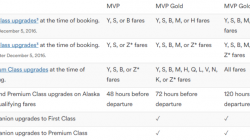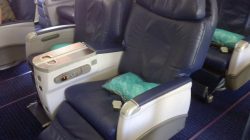I just finished two weeks of heavy travel, going to FTU in Washington, DC; two mileage runs to Indianapolis; BAcon (BoardingArea conference) in Colorado Springs, and a visit to my family near San Francisco. In short, I’m glad to finally be home for a while.
But during these trips, I reflected on my upgrade success this year on United Airlines, which is at nearly 100%. I have flown roughly 32,000 miles on domestic, upgrade-eligible routes this year, and the only upgrade I truly missed was on a regional jet from Washington-Dulles to Indianapolis with a tiny forward cabin.
I have Premier 1K status, which has been instrumental to that success, but I also have been flying on many G and N fares (N is the new bottom of the barrel, the cheapest fare that still earns full mileage credit). Some people are amazed at this success rate, so I’ll tell you how I do it. You might also be interested in reading my introduction to United’s upgrade policies, though the lessons below will apply to almost any carrier.
Lesson 1: Don’t Live Near a Hub
Elite status is a major factor in processing upgrades, so I try to fly on routes where I am less likely to run into other Premier 1K members. Living in Seattle is better than power hubs in San Francisco or Washington with lots of government and business travelers.
Lesson 2: Avoid Others with Equal or Better Status
I connect through Houston because I assume a number of passengers on the plane will actually live in Texas, and it’s difficult for them to accumulate miles when they start in the middle of the country. (Denver, Chicago, and Cleveland are too often on a direct path to my destinations, so stopping there would not earn many extra miles, another important consideration for other reasons.)
Lesson 3: Avoid People Using Instruments
Anyone using a Global Premier Upgrade or Regional Premier Upgrade will trounce me even if they have silver status and a cheaper fare. But people who use these instruments on domestic routes usually save them for nonstop transcontinental flights. I mentioned my preference for Houston, but adding a connection anywhere can improve your odds.
Lesson 4: Fly When Others Won’t
Although it helps save money, too, choosing to travel on redeyes and weekends also means I avoid business travelers who might have elite status or expensive last-minute fares. Instead, I get to compete with a family of four on their only flight of the year who just want something cheap.
For mileage runs, I have the luxury of a flexible schedule that lets me travel mid-week. I have noticed a significant difference in the ease of securing an upgrade on the same route when I compare a busy Monday to a slow Tuesday or Wednesday.
Lesson 5: Use Instruments When Necessary
I have no objection to using an instrument when it is really necessary. I have redeemed Global Premier Upgrades on domestic routes like EWR-SEA and BOS-SFO when I knew I had no chance relying on status alone. This doesn’t bother me because the purpose of an instrument is to secure these most important and difficult upgrades. The important thing is to use them judiciously.
And I’m sure a few people will complain about using Global Premier Upgrades on domestic routes. Listen: I got into this game to begin with because most of my necessary travel was already domestic. The cheapest mileage runs are domestic. When I fly internationally, I usually redeem miles for business class. This means I find no meaningful distinction between Global and Regional Premier Upgrades.
Lesson 6: Pay Attention and Be Assertive
I almost lost an upgrade this year when I was flying from Newark to Seattle. I had redeemed a Global Premier Upgrade, but for whatever reason my reservation would not update and I was still number 12 on the waitlist with just one open seat. My solution was to convince the gate agent to avoid processing any upgrades through the automated system while I spent 20 minutes on the phone getting my ticket manually re-issued. I sat down in my new seat just as boarding was completed.
Lesson 7: Choose Your Plane Wisely
All flights are not equal in terms of seats available for an upgrade. Select a flight that has many seats available, while also considering the ratio of first class to economy class. For example, a Boeing 757 in United’s domestic fleet has one of the largest first class cabins, with 24 first class seats and 158 economy class seats (meaning you have 157 competitors for up to 24 upgrades). A Boeing 737-800 and 737-900 have the same 20 first class seats but different numbers of economy class seats. When I have some flexibility in my schedule, I will pick planes with better upgrade odds. (Many thanks to BoneFishJoe for reminding me of this lesson. I don’t know how I forgot!)
First Class Isn’t Everything
Finally, it is important to remember that getting an upgrade is only one way to improve your travel experience. On two flights this year I gave up a confirmed upgrade in order to make a same day change to an earlier flight. Megan (and I) always enjoy when I get home sooner. I gave up a third upgrade for myself when Megan didn’t clear so I could still sit next to her. On a fourth flight I chose to fly Alaska instead of United because the schedule was much better.
Even when I wasn’t in first class I used other strategies and, yes, my elite status to make sure I had one of the best seats in economy class. Given how lazy I have been about hitting the gym lately, I probably don’t need any extra gin and tonics anyway.




